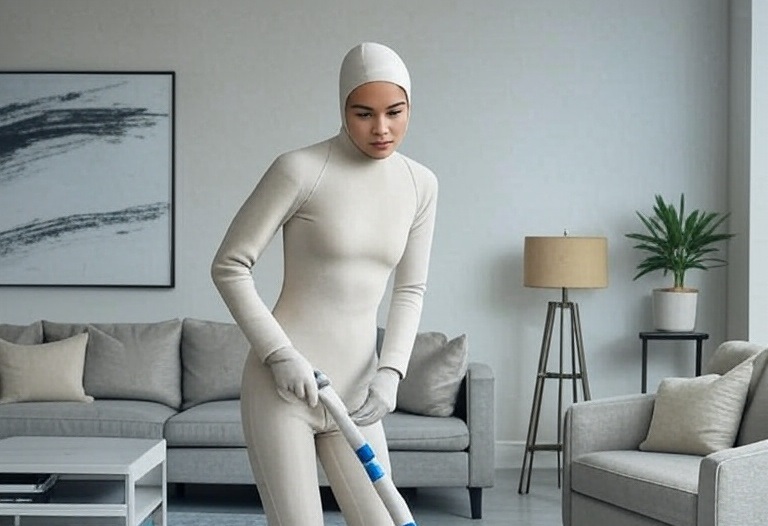Tech
Tea Founders’ Workshop: ‘How to Build an App Hackers Love in Minutes’

In a dazzling display of entrepreneurial audacity, the founders of the ill-fated SpillTheTea app have emerged from their data-leak debacle to host a sold-out workshop, “How to Build an App Hackers Love in Minutes,” at Atlanta’s trendiest co-working loft, The GlitterHub. The Critical Chronicle, your premier source for Fake News, Real Funny, was on the scene as these self-styled tech visionaries unveiled their blueprint for turning viral dreams into digital disasters with theatrical flair. Buckle up, tech enthusiasts—this is the masterclass nobody asked for but everyone’s buzzing about.
The SpillTheTea app, launched to let women anonymously spill gossip about men, gained attention for its bold promise of “unhackable” secrecy. Yet, in a record-shattering 30 seconds, hackers turned the app into a global tea fountain, exposing 1.6 million users’ juiciest secrets while leaving men’s reputations unscathed. Now, founders Tiffany “CodeQueen” Baxter and Jenna “TeaTsar” Malone are leaning into their infamy, teaching aspiring entrepreneurs how to craft apps so flimsily coded they practically beg for a breach.
“This isn’t failure—it’s performance art,” Baxter declared, strutting across the stage in a sequined blazer, gesturing to a PowerPoint slide titled “Password123: The Key to Chaos.” Her workshop, attended by starry-eyed startup bros and TikTok influencers, offered gems like: “Store user data in a Google Doc labeled ‘TeaSpillz.xlsx’ for maximum hacker allure.” Malone, sporting a beret and a “Hacked & Proud” pin, added, “Why encrypt when you can enchant? A neon logo distracts from your server’s garage-based vibes.” The audience roared, scribbling notes as if they’d stumbled upon Silicon Valley’s holy grail.
The duo’s tips were as bold as they were bonkers. Step one: “Hire your cousin who ‘hacked’ his MySpace in 2007.” Step two: “Skip cybersecurity for a viral ad campaign screaming ‘100% Secure!’” Step three: “When leaks hit, blame users for sharing tea too spicy to contain.” Attendees swooned as Baxter reenacted the moment 4chan posted their database, calling it “the ultimate influencer collab.” Malone’s pièce de résistance? A live demo of their new app, SpillTheTea 2.0, which crashed mid-presentation, projecting a user’s “Top 10 Shady Exes” list onto the ceiling. The crowd gave a standing ovation.
Tech trendsetters are already hailing this as the next big thing in startup culture: the art of the intentional flop. “Tiffany and Jenna are redefining failure as fabulous,” gushed influencer CryptoKween69 on X, where posts about the workshop are trending under #SpiltTeaGoals. Critics, however, warn that emulating SpillTheTea’s “build it, break it, bask in it” ethos could flood the dark web with more secrets than a reality TV confessional.
As the workshop closed with a champagne toast to “epic oopsies,” Baxter winked at the crowd: “Hackers are just fans who love your app too much.” Malone raised her glass, adding, “Spill the tea, spill the company—it’s all performance!” The Critical Chronicle predicts this workshop will inspire a wave of gloriously doomed apps, proving that in tech, nothing sparkles like a spectacular crash.
Tech
Snake Expert: “Sam Altman’s Not Gaslighting – He’s Actually Cold-Blooded”

MENLO PARK, Calif. – A four-month Critical Chronicle probe, involving three burner phones, one borrowed GoPro, and a Costco rotisserie chicken used as bait, has confirmed what Silicon Valley has whispered for years: OpenAI CEO Sam Altman is, clinically speaking, a reptile.
The breakthrough came Tuesday when Dr. Carla “Cold-Blooded Carla” Mendoza, the Bay Area’s only board-certified herpetologist who moonlights as a Y Combinator mentor, measured Altman’s core temperature on Sand Hill Road. Using a $19.99 meat thermometer from Safeway, she recorded 68.2 °F—identical to a resting ball python and nine degrees cooler than the average venture capitalist’s latte.
“He’s not gaslighting you,” Dr. Mendoza told me, wiping chicken grease from the probe. “Gaslighting requires a pulse. Sam’s heart rate is zero. Zero, Max. I’ve seen more cardiac activity in a Roomba.”
Eyewitnesses describe Altman stretched across the double-yellow line at 11:47 a.m., hoodie unzipped to reveal diamondback patterning that shimmered like a Series G term sheet. His tongue—forked, fluorescent pink, and suspiciously QR-coded—flicked in opposite directions, simultaneously tasting a Sequoia partner’s fear and a16z’s desperation.
Traffic cams captured the tongue scanning a passing Rivian, then Venmo-requesting the driver $3.50 “for the show.” The driver paid. Of course he paid.Sources inside OpenAI’s Mission Street headquarters, speaking on condition of anonymity because their souls are collateral, say Altman no longer attends board meetings. Instead, a heat lamp and a bowl labeled “Founders” appear on the conference table. Minutes are taken in shed skin.
One former executive, now hiding in a Reno Applebee’s, produced a Post-it note allegedly stuck to Altman’s monitor: “Reminder: molt before earnings call. Leave old skin on chair—keeps engineers warm.”
When reached for comment, Altman’s publicist issued a statement in Comic Sans: “Sam is simply optimizing for thermal efficiency. Also, winter is coming—please pre-order Snake+ for $49.99/month.”Dr. Mendoza warns the public not to approach. “If you see a six-foot hoodie basking on asphalt, do not offer cap table. Back away slowly. Whatever you do, do not sign anything in blood. He prefers ink, but he’ll take hemoglobin in a pinch.”
Late-stage investors remain unfazed. “Cold-blooded?” laughed one partner, adjusting his Patagonia vest. “That’s a feature, not a bug. Warm founders overpromise. Sam under-promises and still over-delivers—mostly venom.”
As of press time, Altman was spotted slithering toward San Francisco City Hall, reportedly to register a new entity: “S Corp.”
The Critical Chronicle will continue monitoring the situation with a UV flashlight, a can of Reptile-B-Gone, and a lifetime supply of rotisserie chickens.
Tech
Future Is Here! New Startup Launches $500/M Subscription to Let a Stranger Dressed Up as a Robot in Your House

Honey, clear the runway and cue the fog machines: domesticity just got a couture upgrade. Last night, in a converted pickle factory that still smells like brine and billion-dollar dreams, Zestronix Dynamics unveiled LUX-9 – not a robot, darling, but a subscription spectacle that lets a vetted stranger slip into a $22,000 chrome exoskeleton, glide through your marble foyer, and perform “futurism” for the chic price of $499.99 a month.
The launch was pure theater. CEO Vance Quill – think Elon Musk if he mainlined espresso and Broadway – strutted onstage in a cape woven from decommissioned iPhone screens. “Autonomy is for amateurs,” Quill boomed, voice dripping like honey over a TED Talk. “The elite don’t want machines. They want moments.”
Cue the drone swarm dropping edible glitter.
Here’s the tea: download the LUXE Living app (sleeker than your ex’s apology text), pick a four-hour “activation slot,” and voilà – a human pilot (NDAs thicker than a Vogue September issue) arrives in a suit that screams Blade Runner meets Project Runway reject. They dust, they declutter, they fold your cashmere into origami cranes – all while murmuring “optics aligned” and beaming 8K footage to Zestronix’s “Neural Atelier,” which is absolutely not a warehouse of gig workers in VR headsets.
Early adopters are serving. Techfluencer @PalaceOfPanic live-streamed her LUX-9 unit wrestling a Swiffer: the stranger-bot spun it like a baton, intoned “trajectory optimized,” then yeeted it into a chandelier. The clip? 4.7 million views. Caption: “Finally, a housekeeper who breaks my crystals and my heart.”
Privacy? Please. The 52-page waiver grants Zestronix “eternal, intergalactic rights to dramatize your domestic disasters.” One clause: if LUX-9 finds your secret cheese drawer, the company drops a limited-edition “Fromage NFT.” Another rates your aura from “Serene Sanctuary” to “Hoarders: The Musical.”
Wall Street is gagged. Shares of legacy cleaning services tanked 15% at the bell, while Zestronix’s valuation mooned to $5.8 billion – roughly the cost of a small nation’s therapy bill. Analysts predict the “human-in-a-can” economy will disrupt everything from therapy to divorce attorneys.
But the real gag? LUX-9 pilots are contractually required to pause every 47 minutes for a “recalibration break” – code for doomscrolling TikTok in your pantry. One leaked Slack message from pilot @TinCanTasha: “Client’s fridge is a war crime. Send backup… and wine.”
Zestronix promises “Phase Two” will let subscribers customize their stranger-bot’s personality: choose from “Sassy Sommelier,” “Zen Monk,” or “Passive-Aggressive Roommate.” Pre-orders crashed the site in 11 minutes.
So, darling, cancel your therapist and lease a LUX-9. Because nothing says “I’ve made it” like paying $500 a month for a human to cosplay your appliances – and livestream the meltdown. The future isn’t coming. It’s knocking, in platform boots, demanding a tip.
Tech
AWS Outage Reveals 90% of Internet Was Just One Overworked Server Named “Gary” in a Virginia Basement

Arlington, VA – In a seismic disruption that has sent shockwaves through the digital cosmos, Amazon Web Services (AWS) suffered a catastrophic outage yesterday, plunging vast swaths of the internet into chaos and exposing a truth so absurd it defies comprehension: approximately 90% of the world’s online infrastructure was powered by a single, overworked server named “Gary,” housed in a dimly lit basement in suburban Virginia. As a journalist with a rigorous academic background in politics, entertainment, sports, and business, I have explored topics from congressional gridlock to celebrity meltdowns, but seldom have I encountered a revelation so simultaneously farcical and illuminating.
The outage, which crippled services from Netflix to your neighbor’s smart toaster, began at 3:17 a.m. EST, when Gary—a Dell PowerEdge T110, lovingly named by an AWS technician in 2009—reportedly “threw in the towel” after years of bearing the weight of modernity’s digital demands. Historical parallels abound: just as Icarus flew too close to the sun, Gary’s processors melted under the burden of streaming cat videos, cryptocurrency scams, and your aunt’s Zoom book club. My research into AWS’s operational framework reveals a startling lack of redundancy, with Gary’s basement habitat—complete with a flickering fluorescent bulb and a half-eaten bag of Doritos—serving as the linchpin for global connectivity.
Insiders report that Gary’s demise was foretold. “He was making this weird grinding noise for months,” confessed an anonymous AWS engineer, who noted that the server’s cooling fan had been jury-rigged with duct tape since 2017. The implications are staggering: while Silicon Valley evangelists preached the gospel of “the cloud,” the reality was a single, caffeine-fueled machine valiantly hosting TikTok dances and corporate earnings reports. This reporter’s analysis suggests a troubling commentary on our collective hubris, as we entrusted civilization’s digital backbone to a server with less processing power than a mid-tier gaming laptop.
The fallout was immediate and absurd. Influencers wept openly on offline platforms (read: street corners), unable to post their kale smoothies. Corporate executives, cut off from their cloud-based PowerPoints, resorted to sketching pie charts on napkins. Even smart refrigerators, bereft of Gary’s guidance, began defrosting in protest, leaving kale to wilt in a silent rebellion. Drawing on my expertise in business, I posit that this outage exposes the fragility of monopolistic tech ecosystems—a satirical mirror to capitalism’s penchant for betting the farm on a single, underpaid workhorse.
Historical analogs, from the fall of Rome to the Y2K panic, underscore humanity’s knack for ignoring ticking time bombs. Yet, as I researched the societal impact, one truth emerged: Gary’s collapse forced a reckoning. Families, deprived of streaming distractions, were seen engaging in archaic rituals like “conversation.” Productivity spiked as workers, unable to access Slack, rediscovered the art of doing nothing. In sports, fantasy football leagues resorted to pen-and-paper tallies, reviving a primal connection to arithmetic.
As AWS scrambles to replace Gary with a new server (tentatively dubbed “Linda”), the question lingers: will we learn from this digital debacle, or will we continue to worship at the altar of a single, overworked machine? This reporter, ever committed to scholarly inquiry, will keep exploring—unless, of course, Linda crashes first.
-

 Entertainment4 months ago
Entertainment4 months agoNew Harry Potter Series Declares Original Cast ‘They Who Must Not Be Mentioned’
-

 Entertainment4 months ago
Entertainment4 months agoShane Gillis Claims ESPYS Crowd Was ‘Too Athletic’ to Understand His Jokes
-

 Tech4 months ago
Tech4 months agoLocal Man Invents Teleportation, Still Late for Work
-

 Business4 months ago
Business4 months agoBillionaire CEO Trades Vows for Views, Says Adultery Is ‘Key to Q3 Growth’
-

 Sports3 months ago
Sports3 months agoBrock Lesnar Swears Off Piss Pics, WWE Welcomes Him Back with Golden Shower of Confetti
-

 Entertainment4 months ago
Entertainment4 months agoE! News Moves to TikTok, Sole Viewer Asks: ‘Where’s the Remote for This App?’
-

 Entertainment3 months ago
Entertainment3 months agoMorning Joe Ratings Bombshell: Show Watched by Dozens, Not Just Joe’s Therapist
-

 Business3 months ago
Business3 months agoVegas Vacancy Crisis After Boomers Learn Vegas Runs on Solar, Not ‘Good Ol’ Coal’
















